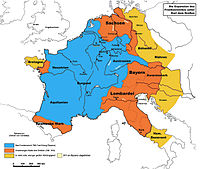Frankish division of the empire
During the entire history of the Franconian Empire , there were numerous divisions , mostly as part of the succession .
Merovingian divisions

Clovis I (466–511), Frankish tribal king from the Merovingian dynasty from the area around Tournai on the Scheldt , united the Franks through war and politics. After his death, the first pan-Frankish kingdom was among his sons Theodoric I. , Chlodomer , Childebert I and Clotaire I. split.
Karl Martell (688-741), Franconian housekeeper, left power in the Frankish empire to his sons, who each became housekeeper in two halves of the empire: Pippin the Younger in Neustria and Karlmann in Austria . In 743, however, Childerich III was of them . used as the last Merovingian king.
Carolingian partitions
Pippin (714-768) put 751 Childerich III. and was crowned the first Carolingian Frankish king . His son Karl the Great was (747-814), his successor, which extends to 771 the kingdom Karlmann I shared (751-771) with. Karlmann I got control of the southern part, from Burgundy and Aquitaine to Alemannia ; Charlemagne over the northern part.
Charlemagne left his son Ludwig I the Pious (778–840) a united, stable empire. Originally, however, Charles had already decided in 806 to divide the empire into sub-kingdoms among his three sons ( Divisio Regnorum ). Ludwig's efforts to leave his sons from two marriages each of their own partial kingdoms, but at the same time to secure imperial unity by awarding the imperial crown and foreign policy sovereignty to the son Lothar I , led to power and distribution wars during Ludwig's lifetime. Three years after his death, the Franconian Empire was permanently divided in the Treaty of Verdun in 843. The western part with Aquitaine went to Charles the Bald (823-877), the central part from the North Sea via Aachen and Rome to the Mediterranean went to Lothar I. (795–855) and the eastern part went to Ludwig the German , (804–876).
After his death, Lothar's part of the empire was divided among his three sons Lothar II (826–869), Ludwig II (822–875) and Charles of Provence (845–863). The north became Lotharingia ( Lorraine ), Charles received Provence and a large part of Burgundy and Louis took over Italy and the dignity of emperors . Ludwig of the German part of the empire split up under his sons into the duchies of Saxony , Bavaria and Swabia . Further divisions and amalgamations alternated. The original expansion of the Franconian Empire was no longer achieved.
The division of Prüm 855 , the Treaty of Meersen 870 and the Treaty of Ribemont 880 confirmed and modified the divisions again.
The Divisio Regnorum by Charlemagne in 806 and the Ordinatio imperii of Louis the Pious in 817 did not become a political reality .
literature
- Franz-Reiner Erkens : Divisio legitima and unitas imperii. Division practice and striving for unity in succession to the throne in the Franconian Empire, in: DA 52 (1996), 423–485.
- Eugen Ewig : Reflections on the Merovingian and Carolingian partitions , in: Nascita dell'Europa ed Europa carolingia: Un'equazione da verificare (Settimane di studio del Centro italiano di studi sull'alto medioevo 27), Spoleto 1981, 225-253.
- Eugen Ewig: Observations on the political-geographical terminology of the Franconian empire and the partial empires of the 9th century , in: Spiegel der Geschichte. Festgabe for Max Braubach on April 10, 1964, ed. by K. Repgen, Münster 1964, 99–140.
- Reinhard Schneider : The unity of the Franconian Empire and the principle of division , in: Lotharingia. A European core landscape around the year 1000. Lectures at a colloquium from May 24th to 26th, 1994 in Saarbrücken, ed. by Hans Walter Herrmann and Reinhard Schneider (published by the Commission for Saarland State History and Folk Research 26), Saarbrücken 1995, 15–30. ISBN 3-930843-02-1 .
- Ian N. Wood : The Franks and their legacy - "Translatio Imperii" , in: The Franks - Trailblazers of Europe, (catalog manual in 2 parts), ed. by Alfried Wieczorek, Mainz 1996, 358-364. ISBN 3-8053-1813-8 .





